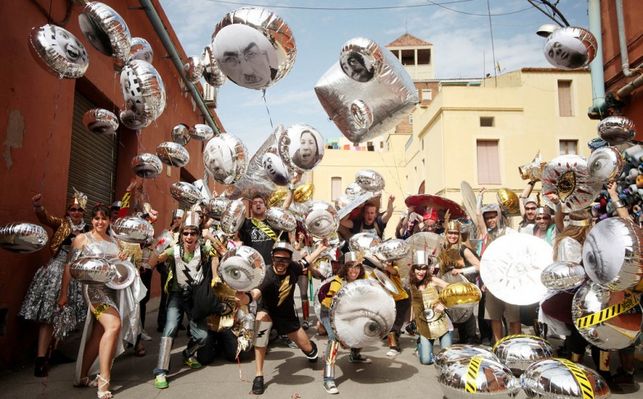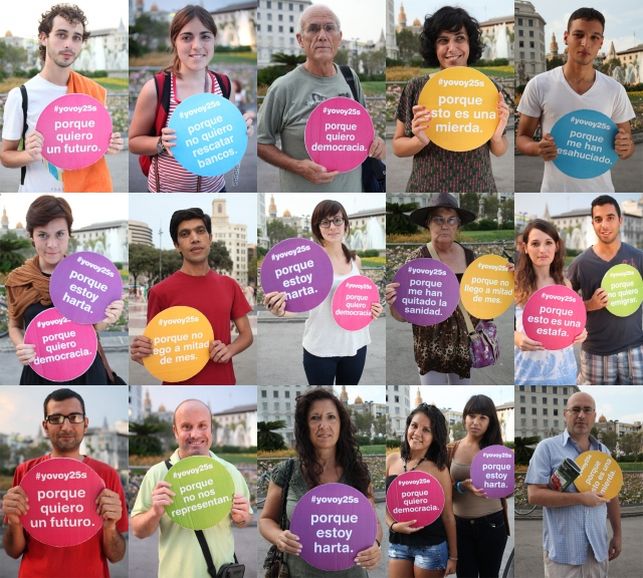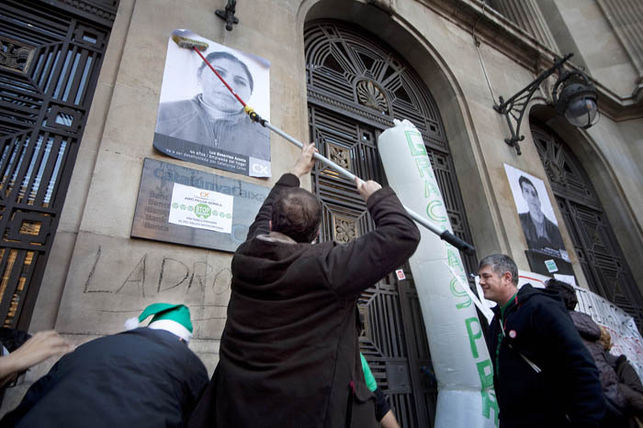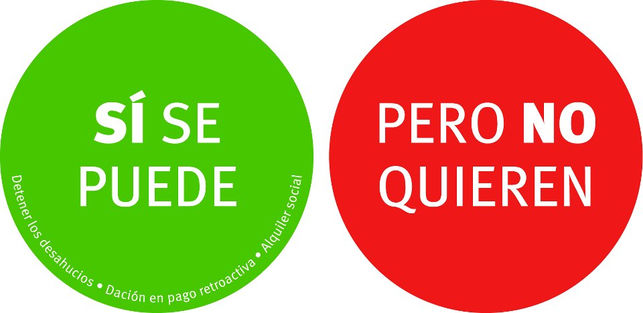The Interruption of the Dominant Narrative, an interview with Colectivo Enmedio
“The interruption of the dominant narrative to create our own is the sort of politics we’re interested in” Amador Fernández-Savater interviews colectivo Enmedio
Frustrated by the lack of connection between art and political action, Campa, Leo, Mario y Oriana created, among others, the colectivo Enmedio (“InBetween collective”) (Barcelona) to explore the transformative potential of images and tales. They recently hacked the statue of Columbus in Barcelona and, amongst many other initiatives, they are also responsible for the striking visual campaign used by Spain’s anti-foreclosure movement, the PAH, to highlight and publicly shame corrupt politicians responsible for maintaining Spain’s draconian foreclosure laws. We talk to them about art’s power to politically intervene, both practically and potentially, in the crisis.
A space in Barcelona, an art collective, an action group, what exactly is Enmedio?
Leo: The name says a lot about us. Enmedio is born of heartbreak. We’re all image professionals (designers, filmmakers, artists, etc.) who’ve left our usual work behind. We found no meaning in the spaces we were assigned: the art academy, the advertising agency, the production company. So we got out of that and came up with a new space where can do what we want, a bit of an uncomfortable and difficult space in a no-man’s-land.
Campa: There’s no politics in the established spaces for art (though there’s no lack of politicking!) nor will you find a whole lot of concern about aesthetics in political spaces. This is what pushed us to create a third space, to be in-between art and politics.
Mario: Visual work can be very powerful and that’s something that we want to keep exploring. It’s our thing, it’s what we do best and the way we relate to the world. But we need to take that to other places and mix it up with other things. “Enmedio” makes reference to that unknown space we want to occupy, that has something to do with photography or vídeo, but it isn’t just that, although it has that too, I don’t know if I’ve made myself clear….
Oriana: We’ve been exploring this edge for some ten or twelve years. Some of us come from collectives like Las Agencias, Yomango, V de Vivienda, etc. There are people who’ve been involved in squats, or the anti-globalization protests, or Latin American movements, like Zapatismo, and people with no political history, or otherwise informed by today’s movements: V de Vivienda, 15-M, etc. This mix of different creative and political backgrounds breaks our individual roles when working together and produces some surprising effects; that may be our strongest suit.
Does symbolic political intervention make a difference during a crisis like this, which touches and affects the most material and real sides of our lives (housing, salaries, etc.)?
Campa: Capitalism drives us to this sort of misery, to these foreclosures and this suffering, through images and tales. It’s a master storyteller with an impressive capacity to fascinate. Lots of people got mortgaged because they bought the story, built on words and images, that we got from banks and advertising on a daily basis. Advertising creates images of desirable worlds, and that collective image generates economic paradigms and social situations.
Leo: It’s not like on the one hand we have this fiction, and on the other, reality. Fiction is the hard nucleus of reality. From a protest (an act of street-theatre) to the writing of a political speech (which deals with images and popular imagery), it’s all fiction. What’s important is the effect of these fictions, whether we can re-appropriate them or not, whether we believe in them or not, whether they generate confidence or impotence in ourselves. The basis for social change is cultural: the stories through which we make sense of our lives and the world we live in.
Mario. That’s the reason why we work in two directions. First, to interfere with the dominant narrative, the official explanation for the world, through guerrilla communication, with signs, catchphrases, messages, etc. Second, contributing to the production of an autonomous imagery. Not as much breaking down a narrative as bringing in a new one. This is what’s most important and most difficult: to represent ourselves, create our own story, our own explanation of what’s happening. A narrative we can inhabit.
Let’s explore all this in more detail, by way of your own actions. If you want, we can start with the party at the unemployment agency INEM [1] that you organised in 2009
Fiesta en INEM. Press the close-caption button to activate English subtitles.
Oriana: Maybe the most interesting thing was the moment: the crisis erupts, but there’s no reaction in the street. There’s fear and paralysis. Our idea was to find a place that condensed and represented that fear. We chose the unemployment office, and what better solution to fear than throwing a party?
Campa: Enmedio functions through self-representation. What I mean is, it wasn’t a party for the unemployed. We’re also unemployed, we live precariously, etc. We’re not lecturing anybody. We start by looking at ourselves, and then we invite everyone else to join. In the vid you can see people smiling, participating, cheering or telling us “you’ve cheered up my day”. We look for that empathy by starting with our own worries, problems and woes.
Leo: That video got an amazing amount of views. I think we touched on something that vibed with a shared feeling: if you start with what’s bothering you personally, you can communicate it to others. What’s most intimate is, at the same time, most common.
Mario: We want our actions to be inspiring and contagious. We plan and design them as seeds that can take root elsewhere. Once the 15-M movement got started, we saw parties thrown at an INEM office in the Canary Islands, and other similar actions.
Tell us about the Reflectors.

Leo: The Reflectantes (Reflectors) is an action group that sprang from a series of creative activism workshops we called “Como acabar con el Mal” (How to end Evil) where we tried to pass on creative activism experiences and practices to younger people who got into politics after 15-M and whatnot. It’s linked to a long tradition of character creation which acts in protest spaces, from Prêt a Revolter to the New Kids on the Black Block, proposing new ways of taking to the street, filled with joy, colour and creativity.
Mario: The Reflectors have a lot to do with the moment they came out, around the first anniversary of 15-M. The powers that be had, by then, gone full thrust with acts of repression and criminalization, in order to end street protest. Bringing in that kind of dynamic leeches the natural plurality from the street, “de-democritising” protest until only small and very homogenous groups remain, easily identified and codified. That’s where the Reflectors come in, saying, “We’re not gonna play this game, let’s break the rules”.
Campa: The Reflectors play with the imagery of superheroes and fan culture. They’re normal people, but armed with a set of tools which allows them to combat Evil: inflatable cubes to deflect the police if they decide to charge, mirrors to blind surveillance ‘copters, disguises to break the codification, etc. They both dramatise and de-dramatise protest by using humour and generating new feelings, making street presence desirable again, while, at the same time, putting elements into play that help to channel moments of tension and violence.
Oriana: A lot of people joined the Reflective Block on the 15-M anniversary march. We also met people we didn’t know who had seen the costumes on the Internet. Nowadays, the Reflectors are an autonomous group, very close to Enmedio, but independent. That’s quite interesting too.
What can you tell me about the Party at Bankia? [2]
Fiesta en Bankia. Press the close-caption button to activate English subtitles.
Mario: The same week the government announced cuts of 20 billion Euros in healthcare and education, we found out that they were going to bail out Bankia with 23 billion Euros in public funds. Like most people, we were furious, so we decided to do something about it.
Leo: We got together with like-minded people and started thinking about what we could do to damage Bankia’s image. We thought that the only way we could affect a bank, and show our rejection of the bailout, was by encouraging people to close their accounts. And the best way to do that would be…throwing a party (as you can see, we just love to throw parties).
Campa: So, one day, a group of people went to a Bankia office, and patiently crouched and waited for a client to close her account. Then we went in and threw a party for her. She couldn’t believe it. We were in there for four minutes at the most, that’s how long the song lasted. We lifted her up and carried her out over our heads, and got out of there the same way we came in. We then cut a video out of all this and it got more than 100.000 visits in 24 hours and hasn’t stopped since. The YouTube page is full of comments. The vid was shown on various TV channels, and other “Cierra Bankia” parties took place in cities all across Spain.
Oriana: The idea was to show that something as intimate and private as your bank account can be used as a political statement; that closing an account can be a public act, and, above all, a lot of fun!

What was the Discongreso (De-congress)?
Mario: Enmedio joined the 25-S campaign: “Ocupa el congreso” (Occupy Congress). It was a call to action that coincided with our own internal debates: We felt that 15-M had fallen into some repetitive inertias and that 25-S could be a good occasion to break out of them. The problem was that it was a very insular call to action, both exclusive and codified. Our work there was to use communication as a way of opening it up. WIth the posters, a graphic campaign and a proposal to occupy the space in a different way, we wanted to come up with a different story, reappropriate the event, and make it both open and desirable.
Oriana: Design-wise, it was a very simple campaign. We replaced “Occupy Congress” for “Surround Congress”, because for us it was never about taking power but a removal of power. Then we added. “On 25-S we’ll surround Congress until they resign. Period”. In the poster we had a series of different coloured dots, representing a plural society, surrounding a centre.
Campa: Those dots actually become pictures later on. We put out a photocall inviting people to take pics showing their own reasons for going to an event like 25-S. We took the photocall out to the street, and we put the word out on social media so people could take their own pics and add their reasons. We wanted to highlight diversity and open up an event that, at first, had felt very exclusive.
Leo: And finally, the dots were turned into frisbees on which people wrote their demands. We then sent these on to Congress, flying over police barricades during the actual protest on September 25th. Since, by land, there was no way to get into Congress so they’d listen to us, the only option we had was by air!

Tell me about the “We are Not Numbers” Action Photography Workshop.
Oriana: Working with photographs and, in collaboration with PAH, we wanted to reverse the dehumanised and victim-like portrayals of people affected by foreclosure that the media puts out. We portrayed people about to be foreclosed, or who had already been kicked out, and we pasted those portraits, all blown up, on the banks that had led to their situations, showing that the foreclosed have faces and eyes, that they’re not just statistics. And from those pictures, we’ve also designed a series of postcards where we tell these people’s stories. These were directed, first of all, to the banks, and later (during the escraches), to politicians.
Campa: These photographic interventions work in two ways. On the one hand, they empower the affected. They come to the workshop, they pose, see their photographs, then they’re pasted up on the banks, and like this we break the wall of shame, they create a presence in public space. On the other, it’s guerrilla imagery in the struggle between different depictions of the crisis, the day-to-day battle held on the walls of the cites, associating a face with the organization responsible for the foreclosure (foreclosures are often talked about in the media, but they never mention the names of the banks). The interruption of the dominant narrative to create our own is the sort of politics we’re interested in.
Leo: For us, the real key isn’t the quality of the portraits or videos, but their coordination with social processes as powerful as PAH. But we’re also quite careful and exacting about form. We don’t share the sloppiness of those that think that “the content” of the picture or poster is the only worthwhile thing. We’re concerned about aesthetics, not out a love for aestheticism itself, but because of the very politics of aesthetics: the “how” of relating these things, the “what” we’re given to see, the “what” we’re led to feel”. Lacking form, there’s only naked rage and no communication.
You’ve also designed the popular red and green signs used by the PAH in their escraches[3]. A friend, after being in a escrache, told me “Those simple signs are so important; without them we’d just seem to be a furious mass, and little else”

Leo: The problem with housing has always been central to us. Some of us took part in the graphic commission of V de Vivienda-Barcelona [4], where we came up with the famous slogan: “You’ll never own a house in your whole fucking life.” So, during the “No somos números” (We’re not numbers) workshop we formed a direct relationship with the PAH, and they asked us to take care of the visual side of the escraches. It was a very important proposal for us and, at the same time, a very delicate one.
Mario: The idea was to lay out the conflict with a very simple visual statement. On one side we have the “Yes we can” from the PAH (the million signatures, the social support, etc). On the other side, the “But they don’t want to”, coming from the political elite, totally deaf to society. Green and red: walk and stop. A lot of green signs against a lone red one: 99% and 1%. The signs and stickers weren’t so much designed to point to any specific politicians but, more than anything, to gather and serve the outpouring of social support the PAH has had.
Oriana: In the original Argentinian escraches, the neighborhood played a crucial role. In this case, it was very much the same idea. being able to surround your representative with green buttons on your own neighborhood. That shopkeepers (the baker, the hardware guy, the newspaper vendor) could put the sticker up on their shops. In other words, so that the whole neighborhood would be denouncing the representative, inviting him or her to push the green button. The important thing about the escraches is to pile on people, people from the neighborhood, people who walk by, so that anyone can be part of the “green tide” as represented by the PAH. That’s the effect we wanted to have with the signs.
Campa: Again, the production side of this has been very important, how you put this to work. The materials are simple and cheap, the design is up for grabs in PAH’s website, so anyone with a printer, some paper and a bit of cellotape can go and make their own signs. We’re just as concerned with the concept (the “what”) as with the production (the “how”).
How about wrapping up by going through some of the main influences or reference points for your work, between images and social concerns, between art and politics?
Oriana: Zapatismo, due to having lived though it myself and because of its meaning. To come from the frivolity and disenchantment of the 90s, to suddenly finding a new way of doing politics and communication. The importance of words and symbols, in the harshest living conditions. Working within and working from the true imagination of the people you work with and the people you want to reach. How central processes, not just results, are.
Mario: Pop music. I see my work as being very related to that, pop culture, what’s popular. This desire to get in touch with the whole of society, the will to push emotions and desires, the yearning to come up with juicy representations where you see yourself reflected, wherever you want to participate, so you can get moving…
Leo: The Yippies, a group created and active in the midst of 60s American counterculture, whose aim was to politically radicalise the hippie movement. Yippies understood social change as a struggle between symbols, and flexed most of their activist muscle creating myths, rumours and fictions to shortcircuit the dominant narrative, and to put in circulation autonomous images. Coming from a very different context, I pretty much think the same way.
Campa: Regarding what I’m concerned with, and given that Zapatismo has already been mentioned, I’d say punk. Not so much in a musical or aesthetic sense, but having to do with sheer attitude, that nerve, freshness, immediacy, nonconformity, DIY culture, the intensity of a 3-minute song. I think that ties in rather well with what we do at Enmedio.
[1] INEM: “Instituto Nacional de Empleo” is Spain’s National Institute for Employment: “Administrative body coming under the Ministry of Labour , set up in 1978 to develop and follow up employment policy , to co-ordinate and run public employment offices and to administer the unemployment benefit system.”
[2] Bankia is Spain´s own big-bank-bailout debacle, going from public bank to private entity, subsequently bankrupting itself and then controversially being rescued with public funds, concurrent with the imposition of austerity measures.
[3] “Escrache”, an Argentinian term, describes a mode of protest wherein people go take their concerns directly to their representative’s homes and neighborhoods to condemn and publicly humiliate decision makers on their unethical choices. Read more here.
[4] Or “H is for Housing” a wordplay on V for Vendetta. Read more here

Produced by Guerrilla Translation under a Peer Production License.
– Translated by Stacco Troncoso
– Edited by Ann Marie Utratel
– This translation has been republished on Shareable
